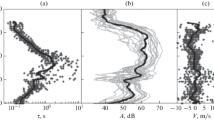Abstract
In this paper we discuss theoretical expressions, determining the difference δφ of Doppler shifts of various coherent radiowave frequencies emitted by a radiator moving in the ionosphere or interplanetary medium. The “rotating” Doppler effect (“Faraday effect”) caused by the Doppler shifts ±δφH of the ordinary and extraordinary waves is also considered. In a three-dimensional inhomogeneous ionosphere, stationary in time (∂N/∂t = 0), δφ is determined in the general case, by an equation with three variables. The equation for δφ proper depends only on the local value of the electron concentration N c around the radiator and on integral values, determining, by means of additional calculations, the angle of refraction or its components, the horizontal gradients of electron concentration ∂N/∂x and ∂N/∂y, and in some cases, the integral electron concentration ∫ 0 zcN dz. We describe the analysis of the δφ measurements, made with the satellites Cosmos I, II and partially XI, assuming that ∂N/∂t = ∂N/∂y = 0, with a two variables equation. The expected errors are considered. The results coincide well for different points (Moscow, The Crimea, Sverdlovsk) and thus agree with the measurements of δφ H and with height-frequency ionospheric characteristics. The curve giving electron concentration versus height N (z) in the outer ionosphere (above the maximum of F2), shows a new maximum higher than the main maximum of the ionosphere N MF2 at 120–140 km. At this maximum the value of N (z) is (0.9–0.95) N MF2. The new data on the large-scale horizontal inhomogeneities of the ionosphere, exceed the previous ones by about a factor 10. By means of the irregular variations of δφ the spectrum W(ϱ) of the inhomogenous formation is determined. Three unknown constant maxima with values ϱ ∼ 16 to 18 km, 28 to 32 km and 100 to 120 km are found. The spectrum W (ϱ) mainly characterizes the local properties of the ionosphere along the orbit of the satellite.
Similar content being viewed by others
References
Al'pert, Ja. L.: 1960, Usp. Fiz. Nauk 71, 369.
Al'pert, Ja. L., Beljanskij, V. B., Mitjakov, N. A.: 1963, Geomagn. i Aeronom. 3, 10.
Al'pert, Ja. L., Beljanskij, V. B., Kutjakov, A. F.: 1963, Geomagn. i Aeronom. 3, 167.
Al'pert, Ja. L.: 1963, Geomagn. i Aeronom. 3, 626.
Mitjakov, N. A., Mitjakova, E. E., Čerepavickij, V. A.: 1963, Geomagn. i Aeronom. 3, 816.
Mitjakov, N. A., Mitjakova, E. E.: 1963, Geomagn. i Aeronom. 3, 858.
De Mendoza, F.: 1962, J. Geophys. Res. 67, 2315.
Yeh, K. C., Swenson, G. W.: 1961, J. Geophys. Res. 66, 1061.
Garriot, O. K.: 1960, J. Geophys. Res. 65, 1139, 1151.
De Mendoza, F., Garriot, O. K.: 1962, J. Atm. Terr. Phys. 24, 317.
Golton, E.: 1962, J. Atm. Terr. Phys. 24, 554.
Smelovskij, K. H., Klinker, P., Knut, F.: 1963, Geomagn. i Aeronom. 3, 25; Gerlands Beitr. Geophys. 68, (1959) 321; 69, (1960) 329, 351; 70 (1961) 201
Cedilina, E. E.: 1962, Geomagn. i Aeronom. 2, 865.
Al'pert, Ja. L.: 1958, Usp. Fiz. Nauk 64, 3.
Cedilina, E. E.: 1964, Geomagn. i Aeronom. 4, No. 3.
Author information
Authors and Affiliations
Rights and permissions
About this article
Cite this article
Al'pert, J.L. Some results of ionospheric investigations by means of coherent radiowaves emitted by satellites. Space Science Reviews 4, 5–34 (1965). https://doi.org/10.1007/BF00347153
Received:
Issue Date:
DOI: https://doi.org/10.1007/BF00347153



